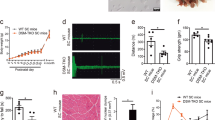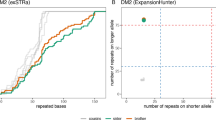Abstract
Myotonic dystrophy (DM) is associated with the expansion of a (CTG)n trinucleotide repeat in the 3′ untranslated region (UTR) of the DM protein kinase gene (DMPK)1. The (CTG)n repeat is polymorphic and varies in size between 5 and 37 repeats in unaffected individuals1 whereas in affected patients there are between 50 and 4,000 CTGs2,3. The size of the (CTG)n.repeat, which increases through generations, generally correlates with clinical severity and age of onset4. The instability of the CTG repeat appears to depend on its size as well as on the sex of the transmitting parent5–9. Moreover, mitotic instability analysis of different human DM tissues shows length mosaicism between different cell lineages3,6,10–14. The molecular mechanisms of triplet instability remain elusive. To investigate the role of genomic sequences in instability, we produced transgenic mice containing a 45-kb genomic segment with a 55-CTG repeat cloned from a mildly affected patient. In contrast to other mouse models containing CAG repeats within cDNAs, these mice showed both intergenerational and somatic repeat instability15–17
This is a preview of subscription content, access via your institution
Access options
Subscribe to this journal
Receive 12 print issues and online access
$209.00 per year
only $17.42 per issue
Buy this article
- Purchase on Springer Link
- Instant access to full article PDF
Prices may be subject to local taxes which are calculated during checkout
Similar content being viewed by others
References
Harris, H., Moncrieff, C. & Johnson, K. Myotonic Dystrophy: will the real gene please step forward!. Hum. Mol. Genet. 5, 1417–1423 (1996).
Lavedan, C., Hofmann-Radvanyi, H., Rabes, J. P., Roume, J. & Junien, C. Different sexdependent constraints in CTG length variation as explanation for congenital myotonic dystrophy. Lancet. 341, 237 (1993).
Thornton, C. A., Johnson, K. & Moxley, R.T.r. Myotonic dystrophy patients have larger CTG expansions in skeletal muscle than in leukocytes. Ann. Neurol.. 35, 104–107 (1994).
Harper, P.S., Harley, H.G., Reardon, W. & Shaw, D.J. Anticipation in myotonic dystrophy: new light on an old problem. Am. J. Hum. Genet. 51, 10–16 (1992).
Brunner, H.G. et al. Influence of sex of the transmitting parent as well as of parental allele size on the CTG expansion in myotonic dystrophy (DM). Am. J. Hum. Genet. 53, 1016–1023 (1993).
Lavedan, C. et al. Myotonic dystrophy: size- and sex-dependent dynamics of CTG meiotic instability, and somatic mosaicism. Am. J. Hum. Genet. 52, 875–883 (1993).
Ashizawa, T., Dunne, P.W., Ward, P.A., Seltzer, W.K. & Richards, C.S. Effects of the sex of myotonic dystrophy patients on the unstable triplet repeat in their affected offspring. Neurology 44, 120–122 (1994).
Harley, H.G. et al. Size of the unstable CTG repeat sequence in relation to phenotype and parental transmission in myotonic dystrophy. Am. J. Hum. Genet. 52, 1164–1174 (1993).
Jansen, G. et al. Gonosomal mosaicism in myotonic dystrophy patients: involvement of mitotic events in (CTG)n repeat variation and selection against extreme expansion in sperm. Am. J. Hum. Genet. 54, 575–585 (1994).
Anvret, M. et al. Larger expansions of the CTG repeat in muscle compared to lymphocytes from patients with myotonic dystrophy. Hum. Mol. Genet. 2, 1397–1400 (1993).
Ashizawa, T., Dubel, J.R. & Harati, Y. Somatic instability of CTG repeat in myotonic dystrophy. Neurology 43, 2674–2678 (1993).
Monckton, D.G., Wong, L.J.C., Ashizawa, T. & Caskey, C.T. Somatic mosaicism, germline expansions, germline reversions and intergenerational reductions in myotonic dystrophy males: small pool PCR analyses. Hum. Mol. Genet. 4, 1–8 (1995).
Wohrle, D. et al. Heterogeneity of DM kinase repeat expansion in different fetal tissues and further expansion during Cell proliferation in vitro: Evidence for a causal involvement of methyl-directed DNA mismatch repair in triplet repeat stability. Hum. Mol. Genet. 4, 1147–1153 (1995).
Wong, L.J.C., Ashizawa, T., Monckton, D.G., Caskey, C.T. & Richards, C.S. Somatic heterogeneity of the CTG repeat in myotonic dystrophy is age and size dependent. Am. J. Hum. Genet. 56, 114–122 (1995).
Bingham, P.M. et al. Stability of an expanded trinucleotide repeat in the androgen receptor gene in transgenic mice. Nature Genet. 9, 191–196 (1995).
Burright, E.N. et al. SCA1 transgenic mice: a model for neurodegeneration caused by an expanded CAG trinucleotide repeat. Cell 82, 937–948 (1995).
Goldberg, Y.P. et al. Absence of disease phenotype and intergenerational stability of the CAG repeat in transgenic mice expressing the human Huntington disease transcript. Hum. Mol. Genet. 5, 177–185 (1996).
Jansen, G. et al. Characterization of the myotonic dystrophy region predicts multiple protein isoform-encoding mRNAs. Nature Genet. 1, 261–266 (1992).
Boucher, C.A. et al. A novel homeodomain-encoding gene is associated with a large CpG island interrupted by the myotonic dystrophy unstable (CTG)n repeat. Hum. Mol. Genet. 4, 1919–1925 (1995).
Brook, J.D. et al. Molecular basis of myotonic dystrophy: expansion of a trinucleotide (CTG) repeat at the 3′ end of a transcript encoding a protein kinase family member. Cell 68, 799–808 (1992).
Fishel, R. et al. The human mutator gene homolog MSH2 and its association with hereditary nonpolyposis colon cancer. Cell 75, 1027–1038 (1993).
Strand, M., Prolla, T.A., Liskay, R.M. & Petes, T.D. Destabilization of tracts of simple repetitive DNA in yeast by mutations affecting DNA mismatch repair. Nature 365, 274–276 (1993).
Imbert, G., Kretz, C., Johnson, K. & Mandel, J.L. Origin of the expansion mutation in myotonic dystrophy. Nature Genet. 4, 72–76 (1993).
Gibbs, M., Collick, A., Kelly, R.G. & Jeffreys, A.J. A tetranucleotide repeat mouse minisatellite displaying substantial somatic instability during early preimplantation development. Genomics 17, 121–128 (1993).
Barcelo, J.M., Mahadevan, M.S., Tsilfidis, C., MacKenzie, A.E. & Korneluk, R.G. Intergenerational stability of the myotonic dystrophy protomutation. Hum. Mol. Genet. 2, 705–709 (1993).
Mathieu, J. Genealogical reconstruction of myotonic dystrophy in the Saguenay-Lac-Saint-Jean area (Quebec, Canada). Neurology 40, 839–842 (1990).
Baker, S.M. et al. Male mice defective in the DNA mismatch repair gene PMS2 exhibit abnormal chromosome synapsis in meiosis. Cell 82, 309–319 (1995).
Baker, S.M. et al. Involvement of mouse MIH1 in DNA mismatch repair and meiotic crossing over. Nature Genet. 13, 336–342 (1996).
de Wind, N., Dekker, M., Berns, A., Radman, M. & te Riele, H. Inactivation of the mouse Msh2 gene results in mismatch repair deficiency, methylation tolerance, hyperrecombination, and predisposition to cancer. Cell 82, 321–330 (1995).
Gourdon, G., Sharpe, J.A., Wells, D., Wood, W.G. & Higgs, D.R. Analysis of a 70 kb segment of DNA containing the human zeta and alpha- globin genes linked to their regulatory element (HS-40) in transgenic mice. Nucl. Acids Res. 22, 4139–4147 (1994).
Author information
Authors and Affiliations
Corresponding author
Rights and permissions
About this article
Cite this article
Gourdon, G., Radvanyi, F., Lia, AS. et al. Moderate intergenerational and somatic instability of a 55-CTG repeat in transgenic mice. Nat Genet 15, 190–192 (1997). https://doi.org/10.1038/ng0297-190
Received:
Accepted:
Issue Date:
DOI: https://doi.org/10.1038/ng0297-190
This article is cited by
-
Nucleosomal occupancy and CGG repeat expansion: a comparative analysis of triplet repeat region from mouse and human fragile X mental retardation gene 1
Chromosome Research (2011)
-
Tissue- and age-specific DNA replication patterns at the CTG/CAG-expanded human myotonic dystrophy type 1 locus
Nature Structural & Molecular Biology (2010)
-
Features of trinucleotide repeat instability in vivo
Cell Research (2008)
-
Repeat instability: mechanisms of dynamic mutations
Nature Reviews Genetics (2005)
-
Instability of (GATA) n microsatellite loci in the parthenogenetic Caucasian rock lizard Darevskia unisexualis (Lacertidae)
Molecular Genetics and Genomics (2004)



